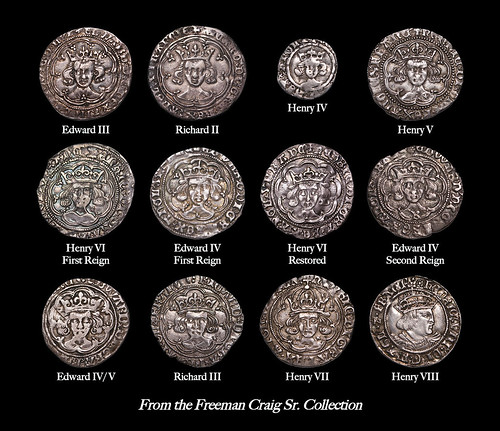
PREV ARTICLE
NEXT ARTICLE
FULL ISSUE
PREV FULL ISSUE
FACING BUSTS: ENGLISH KINGS FROM 1351 TO 1526Allan Davisson published this article via email on August 12th, 2020. With permission we're republishing it here. -Editor
Discriminating portraits is a substantial area of research and interest for numismatists. The US series of coins has volumes devoted to discriminating dies for such issues as early copper coins (Sheldon) and half dollars (Overton). While milled coinages in the English series show age progression of long-serving monarchs (e.g. Elizabeth II), some portrait sequences like those showing the young head of Victoria feature important distinctions as well. Yet, the English medieval portraits are typically not the basis for definitive attributions in this series. More commonly—after the name of the king— the initial marks at the beginnings of the legends and the lettering and legends themselves are the keys to dating and mint progressions. Yet, the portraiture itself marks major turning points in English coin design.

With the hammered coinage series that began with the Fourth Coinage of Edward III in 1351, and ended with the introduction of a Renaissance-inspired portrait of Henry VII with the 1526 Second Coinage of Henry VII, a graver’s tool was required to create the king’s image. This approach replaced the use of punches and a mechanical approach that resulted in an outcome of a simplistic style. (Oman, 1931, a capable historian of English numismatics, called the portraits of that earlier type “inhuman and barbarous.”) This later facing bust with locks of hair flaring out left and right and arches and fleurs (usually) framing the portrait marked England’s growth and expansion for 175 years. Whether there was a design evolution over this period is debatable. There is an ornateness to the crowns of Henry VII that is not seen earlier, but the facial details are generally similar. Rather than portraiture, most of the research on coinage of this era focuses on legends and lettering. Yet the nature of the crown, elements of the eyes, aspects of the drapery, additional symbols such as a mullet on the shoulder (Henry V) or symbols in the field or on the breast (Henry VI) provide readily distinguishing characteristics for different issues. Some of the portraits have an appearance that seems to signal something more than just a basic image like the various busts North notes of Henry V–“emaciated, scowling, frowning.” The nature of the eyes on the portraits varies–sunken dots, missing eyebrows, pronounced arcs above and below; mouths that can vary from small with pursed lips to shapes resembling a leer or a frown. The crowns also vary in many ways—the shape of the fleurs, the number of arches, jewels on the arches. In time, as you become more and more familiar with this period of English history and English coinage, these portraits begin to express a charm all their own. Oman commented about the full-face of Edward III on the first of his groats that “Why the king did not place a real portrait on this new coin is hard to see. His artist could have produced a very good one, if he had but given the order.” But “real portraits” were not typical of mid-14th century art, and it is not hard to imagine that a “real portrait” would not have been accepted by a society whose experience with art was still in the early stages of emergence from medieval expression. (Charles Oman, K.B.E. The Coinage of England. Oxford. 1931)
To view the Freeman Craig Sr. Introduction, and the entire back cover, see:
To browse the Freeman Craig Sr. Collection, see:

Wayne Homren, Editor The Numismatic Bibliomania Society is a non-profit organization promoting numismatic literature. See our web site at coinbooks.org. To submit items for publication in The E-Sylum, write to the Editor at this address: whomren@gmail.com To subscribe go to: https://my.binhost.com/lists/listinfo/esylum All Rights Reserved. NBS Home Page Contact the NBS webmaster 
|
